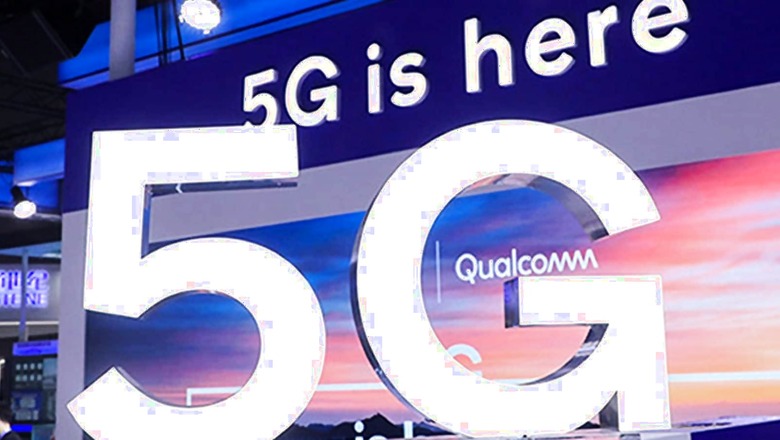
views
With 5G Spectrum auctions happening online in full-swing starting July 26, telcos like Reliance Jio, Bharti Airtel and Adani placed bids worth Rs 1.45 lakh crore on the first day to acquire 5G spectrum. The revenue collection from the first day of the spectrum auction is reported to be Rs 1.09 lakh crore. Note that all the radio waves sold on the first day were at the reserve price.
In India, the 5G spectrum that is being auctioned include 600 MHz, 700 MHz, 800 MHz, 900 MHz, 1800 MHz, 2100 MHz, 2300 MHz, 2500 MHz, 3300 MHz, and 26 GHz bands. A total of 72097.85 MHz of spectrum has been put to auction and as per government sources the bidding was mostly concentrated around 3300 MHz, 26 GHz and 700 MHz.
The 700Mhz band is always considered as a “premium" band and it sells at a higher price. The reason is simple: the 700 MHz band helps telcos cut costs and provide better network coverage. Due to low frequency and with the ability to penetrate buildings efficiently, the 700MHz band makes all the more sense for telcos to provide connectivity in congested regions.
Due to low frequency and with the ability to penetrate buildings efficiently, the 700MHz band makes all the more sense for telcos to provide connectivity in congested regions.
Despite the obvious advantages of the premium 700MHz band, in 2021, it had remained unsold due to high reserve price. Also, in 2016 auctions, the 700MHz band had failed to attract the interest of telcos in India.
So, if 700Mhz is a premium choice for telcos then why weren’t they buying it? While there were multiple factors, the main reason can primarily be attributed to the financial health of the telecom. With Indian telcos offering the cheapest data price along with calling facilities in the world, it made little sense to buy premium spectrum when the market was already consolidating and the Average Revenue Per User (ARPU) kept falling. Also, the time gap between mainstream 4G launch and introduction of 5G was considered less to get substantial returns after buying 700MHz spectrum. Telcos were basically waiting for 5G auctions to show any interest in acquiring the 700MHz band.
With Indian telcos offering the cheapest data price along with calling facilities in the world, it made little sense to buy premium spectrum when the market was already consolidating and the Average Revenue Per User (ARPU) kept falling.
Increased Demand For 700MHz But 3,300 MHz And 26GHz rule
Sources in the government claim that around 40% of the premium 700MHz spectrum has been sold. As per a report by news agency PTI, provisional bids worth Rs 39,270 crore were received on day-one of auction for the 700MHz spectrum. “All four applicants — Ambani’s Reliance Jio, Mittal’s Bharti Airtel, Vodafone Idea and an Adani group firm “actively" participated in the auction of the 5G spectrum," as per the report.
India is expecting to see rollout of 5G services in certain pockets around September and October. The government is targeting to allocate spectrum by August 15. Telecom minister Ashwini Vaishnaw said telcos can now decide on tariffs for 5G plans. Having said that, it still remains to be seen as to which telco acquired how much airwaves.
Apart from the 700MHz, the 3,300 MHz band attracted bids worth Rs 78,550 crore while the 26 GHz band got bids worth Rs 14,632.50 crore.
Apart from the 700MHz, the 3,300 MHz band attracted bids worth Rs 78,550 crore while the 26 GHz band got bids worth Rs 14,632.50 crore. Now, the 3,300MHz band will be used for 5G communication service while the 26GHz will be focused on providing super high-speed mobile broadband services. Like expected, the 800 MHz and 2,300 MHz bands received no bids on day one of the auctions.
Telcos have been testing 5G services 700 MHz, 3300-3670 MHz and 26 GHz bands for quite some time. Earlier this year, the Telecom Regulatory Authority of India (Trai) had reduced the reserve price of 5G airwaves in the 3300-3670 MHz band by around 36%.So, it is natural for telcos to focus their money more on the 3300 MHz spectrum.
Why is 700MHz considered a ‘premium’ for the growth of 5G in India?
The frequencies in the range of 698 and 806 MHz is way more efficient when compared to the standard 1800MHz. With India’s population density and congestion, there’s no denying that 700MHz will improve the quality of 5G services, especially in urban areas where 5G connectivity will roll out first. Not just that, it costs less for telcos to provide broadband services in the 700MHz band when compared to 2100MHz.
With India’s population density and congestion, there’s no denying that 700MHz will improve the quality of 5G services, especially in urban areas where 5G connectivity will roll out first.
Considering the fact that 4G connectivity will continue to exist in India for the longest time along with 2G for around a decade at least, telcos will have to differentiate with the quality of 5G services if they want subscribers to pay more for 5G data plans. Of course, 5G will be available in patches for some time at least initially, 4G services will continue to remain mainstream in India. While a lot of talk has been made about 5G been 10 times faster than 4G, with the Indian population already contented with the cheap unlimited data plan packs for 4G, it remains to be seen how telcos manage their ARPU expectation while subscribers count their ROI on moving from 4G to 5G.
Read all the Latest News and Breaking News here



















Comments
0 comment